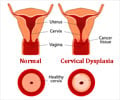New research into the causes of cervical cancer appears to lend weight to the promise of a potential early detection method that could help prevent the disease.
New research into the causes of cervical cancer appears to lend weight to the promise of a potential early detection method that could help prevent the disease.
According to a study involving scientists from the University of North Carolina at Chapel Hill, persistent infection with human papillomavirus (HPV) could be a useful clinical marker for increased risk of cervical cancer, the second most common cancer in women worldwide.HPV is a sexually transmitted virus that can cause high-grade cervical lesions, increasing a woman’s risk of developing invasive cervical cancer.
Currently, Pap smear tests are widely used in screening programs aimed at detecting changes in the cervix before a cancer develops. However, testing for HPV infections has the potential to be more sensitive for future cervical cancer screening programs.
In the study – thought to be the first of its kind and published online in the American Journal of Epidemiology – scientists reviewed 41 existing studies including over 22,500 women to systemically evaluate the association between HPV persistence and high-grade lesions or cervical cancer.
Jennifer Smith, Ph.D., research assistant professor of epidemiology in the UNC School of Public Health and senior author of the paper, said: “We found that a persistent HPV infection of six months to one year was consistently associated with a woman’s increased risk of high-grade cervical lesions or cervical cancer.”
Smith is also a member of the UNC Lineberger Comprehensive Cancer Center.
Advertisement
“The next step will be to develop a consensus definition of HPV ‘persistence’ that can then usefully inform clinical practice for future cervical cancer screening programs,” Smith said. “Additionally, we need more information on whether the persistence of specific HPV types – such as 16 or 18 – is associated with relative differences in increased risk.”
Advertisement
Source-Newswise
SRM











